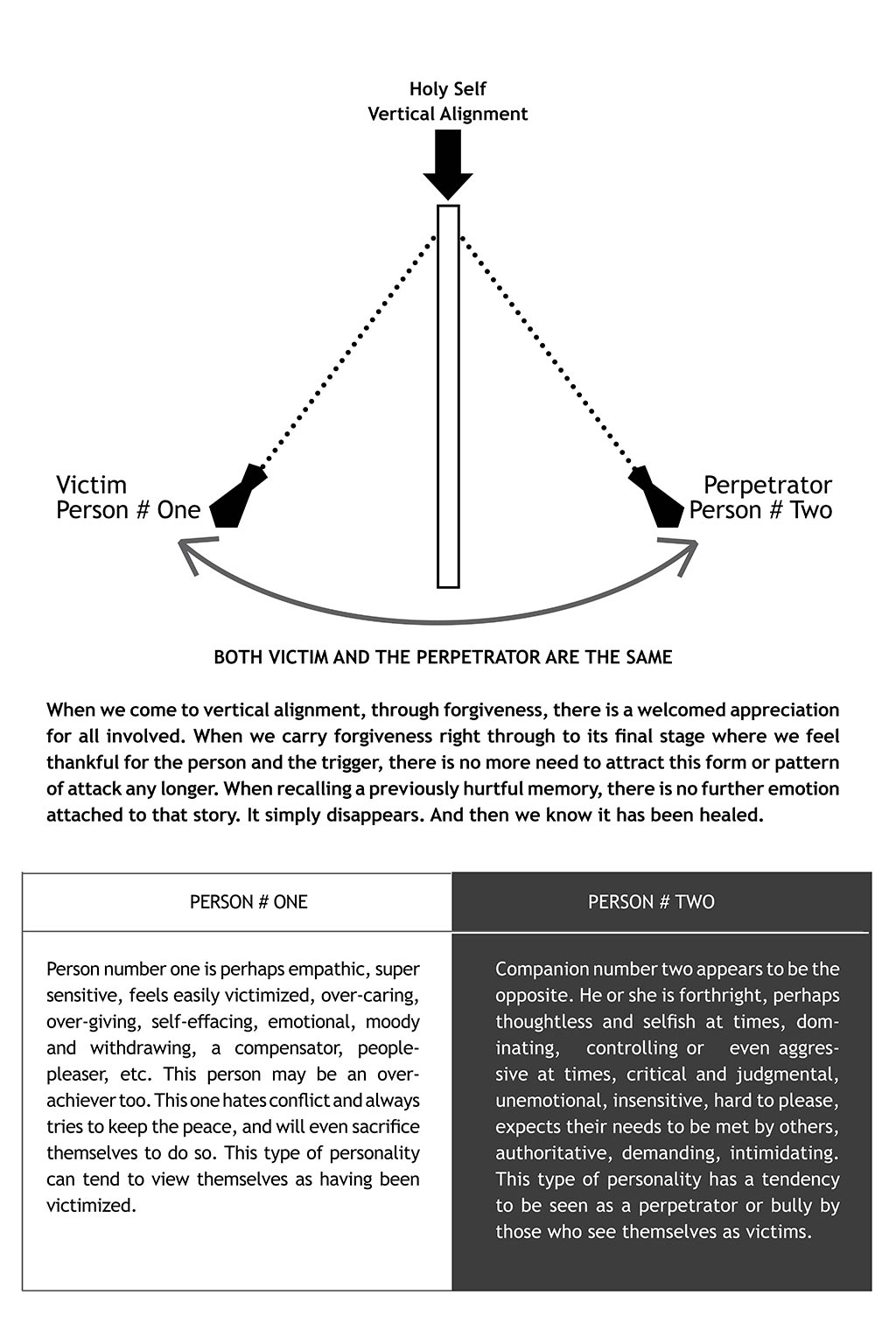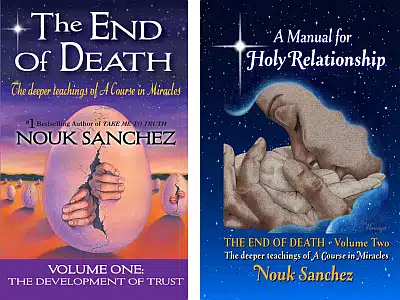Let’s take two seemingly very different people who are in relationship, such as a parent and child, siblings, romantic partnership, friends, colleagues, etc. I will use my earlier unhealed relationship with my mother as a typical example of two people seemingly at odds with each other. Grievances were accumulated, justified, stored and then projected onto each other most of the time.
Please look at the pendulum diagram below and read the accompanying text.

In my case I was largely person number one in the diagram, while my mother happened to be more like the number two individual. We clashed often and sometimes it seemed impossible to communicate with each other.
What many of us now realize is that any unresolved grievances with our parents will always play out repeatedly in adulthood, particularly within relationships with significant others, children, friends and colleagues.
We understand now that our problem is not actually being caused by a particular person judging or attacking us. In truth, a past unhealed and unforgiven pattern is being unconsciously projected onto them. With this recognition, we can choose to constructively use these situations to show us where we still harbor self-hatred. Ideally, when this is recognized as the only reason for our conflict with another, then genuine and deeply felt gratitude erupts for both the trigger and the person, as a consequence.
True forgiveness always ends in welcomed appreciation for all involved. Consistently there is a mighty gift received and extended in forgiveness. When we carry forgiveness right through to its final stage where we feel thankful for the person and the trigger, there is no more need to attract this form or pattern of attack any longer. Another joyous consequence of this is that when recalling a previously hurtful memory, there is no further emotion attached to that story. It simply disappears. And then we know it has been healed.
On the contrary, if we still feel emotional about a past memory of having been victimized then we have not forgiven. The question then is, are we willing to let Holy Spirit reinterpret and repurpose our mistakes (not sins)? Our previously unconscious use of this of type situation, for the purpose of repeating victim patterns, can then be employed to show us specifically where we still hold un-forgiven self-hatred.
“In any union with a brother in which you seek to lay your guilt upon him, or share it with him or perceive his own, [you] will feel guilty. Nor will you find satisfaction and peace with him, because your union with him is not real. You will see guilt in that relationship because you put it there. It is inevitable that those who suffer guilt will attempt to displace it, because they do believe in it. Yet though they suffer, they will not look within and let it go.” T-13.X.3:1-5
Let’s also recall here that the ego carries over its un-forgiven grievances from previous seeming lifetimes and often uses its parents in the current lifetime to project its unhealed self-hatred. Of course, because of the ego’s convenient “amnesia,” we don’t recall this projection of guilt consciously. The ego’s objective is to perpetuate separation by continuing its unquestioned belief in both victims and perpetrators.
Any unforgiven, negative emotional memory is stored in the body and, unless sincerely forgiven, will be projected onto the body as sickness, aging and death. This is the ego’s way of trying to prove that sin, guilt, attack and separation are real and ultimately, more powerful than God’s changeless and all-healing Love, which is our Holy Self.
Victim and victimizer as seeming counterparts, appear to be two opposite polarities, yet they are the same. They personify an equal extent of self-abandonment and self-betrayal. By adopting these conflicting and alien roles, both hide from the light of their shared Holy Self. This Self is in vertical alignment, showing-up in authentic communication using The Seven Key Principles and The Divine Switch.
Just a reminder, our Holy Self cannot be triggered. Only the ego can be triggered. The negative traits in another which trigger us are often our own, secret, self-condemnation. These could not trigger us at all if we didn’t believe that we are unworthy. However, please allow me to attempt to clear up a common confusion. Some on this pathway believe that if we see a problem in others then we ourselves are always projecting that problem. It is our projection contributing to the problem only if we are triggered by what we seem to see or feel. Feeling triggered then, complete with an emotional charge, is the gauge that alerts us to the fact that we our self need forgiveness.
As we heal, we will be able to discern problems and egoic patterns in others, but the defining difference is that we will no longer be triggered by them. In this case the symptoms of ego that we discern with Holy Spirit are not our projections. In other words, all triggers are my own projections requiring forgiveness – until – I am no longer triggered.
Forgiveness rewrites the ego’s story of devastation; it cleans it of all residual attack. And it restores us… gifting us with grace and healing, every time. When we forgive and learn to show-up authentically, using the Seven Key Principles, we remain present in the Holy Instant. There are no victims or perpetrators. No self-betrayal can occur here, and it is in this divine presence that we come to know our Self and others as Love.
“Whenever you feel fear in any form,— and you are fearful if you do not feel a deep content, a certainty of help, a calm assurance Heaven goes with you,— be sure you made an idol, and believe it will betray you. For beneath your hope that it will save you lie the guilt and pain of self-betrayal and uncertainty, so deep and bitter that the dream cannot conceal completely all your sense of doom. Your self-betrayal must result in fear, for fear is judgment, leading surely to the frantic search for idols and for death.
“Forgiving dreams remind you that you live in safety and have not attacked yourself. So do your childish terrors melt away, and [real world] dreams become a sign that you have made a new beginning, not another try to worship idols and to keep attack. Forgiving dreams are kind to everyone who figures in the dream. And so they bring the dreamer full release from dreams of fear.” T-29.IX.9:1-10:4

Please visit our store for more information about my bestselling books, The End of Death (in English, Spanish, German), A Manual for Holy Relationship (in English, Spanish), and others:






Thank you Nouk. I so can relate as I have seen myself as the victim and blah blah blah as the perpetrator. I feel like the charge I used to feel is dying down and now I see my choice to forgive or not – to accept the Atonement or not. All is becoming clearer. Thank you for sharing your insights ?
Thank you Kate <3 We are healing together!
Thank you for sharing this important issue, we ALL learn from this!
I recognize the pattern – and I regognize the healing taking place, as forgiveness is implemented by Holy Spirit through my willingness…
Thank you Nouk?❤️
I’m so glad you recognized this Anne-Marie. Much Love, Nouk <3